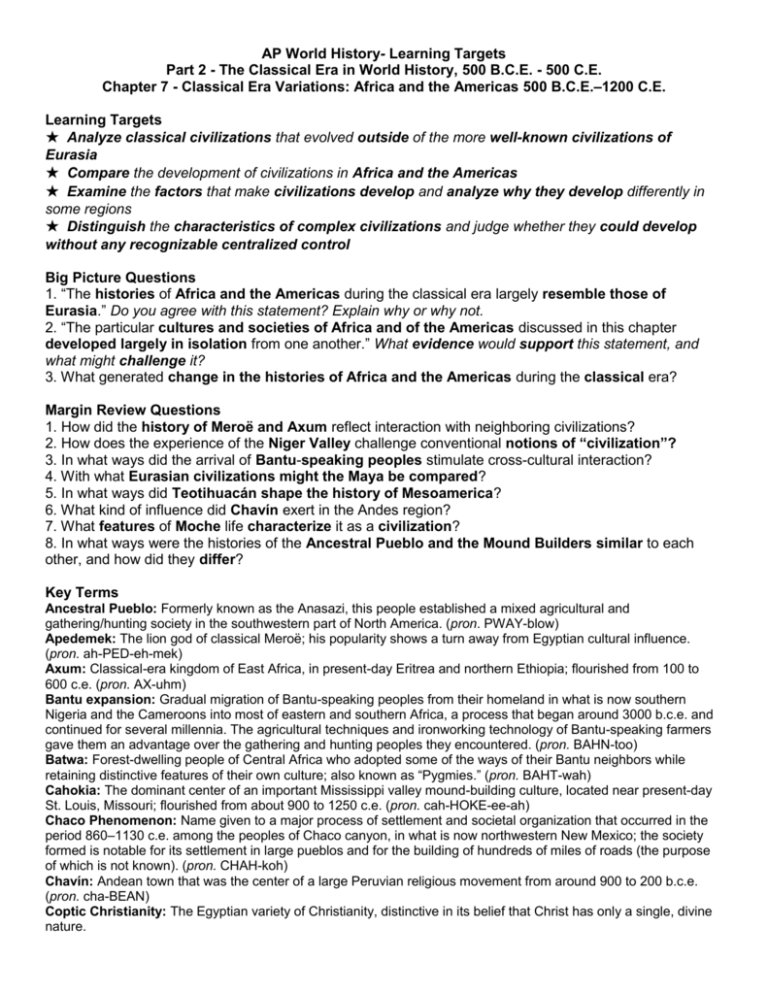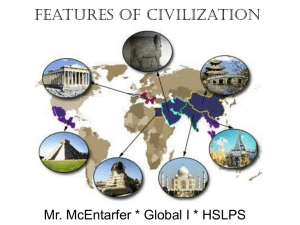Chapter 7 Target Sheet
advertisement

AP World History- Learning Targets Part 2 - The Classical Era in World History, 500 B.C.E. - 500 C.E. Chapter 7 - Classical Era Variations: Africa and the Americas 500 B.C.E.–1200 C.E. Learning Targets ★ Analyze classical civilizations that evolved outside of the more well-known civilizations of Eurasia ★ Compare the development of civilizations in Africa and the Americas ★ Examine the factors that make civilizations develop and analyze why they develop differently in some regions ★ Distinguish the characteristics of complex civilizations and judge whether they could develop without any recognizable centralized control Big Picture Questions 1. “The histories of Africa and the Americas during the classical era largely resemble those of Eurasia.” Do you agree with this statement? Explain why or why not. 2. “The particular cultures and societies of Africa and of the Americas discussed in this chapter developed largely in isolation from one another.” What evidence would support this statement, and what might challenge it? 3. What generated change in the histories of Africa and the Americas during the classical era? Margin Review Questions 1. How did the history of Meroë and Axum reflect interaction with neighboring civilizations? 2. How does the experience of the Niger Valley challenge conventional notions of “civilization”? 3. In what ways did the arrival of Bantu-speaking peoples stimulate cross-cultural interaction? 4. With what Eurasian civilizations might the Maya be compared? 5. In what ways did Teotihuacán shape the history of Mesoamerica? 6. What kind of influence did Chavín exert in the Andes region? 7. What features of Moche life characterize it as a civilization? 8. In what ways were the histories of the Ancestral Pueblo and the Mound Builders similar to each other, and how did they differ? Key Terms Ancestral Pueblo: Formerly known as the Anasazi, this people established a mixed agricultural and gathering/hunting society in the southwestern part of North America. (pron. PWAY-blow) Apedemek: The lion god of classical Meroë; his popularity shows a turn away from Egyptian cultural influence. (pron. ah-PED-eh-mek) Axum: Classical-era kingdom of East Africa, in present-day Eritrea and northern Ethiopia; flourished from 100 to 600 c.e. (pron. AX-uhm) Bantu expansion: Gradual migration of Bantu-speaking peoples from their homeland in what is now southern Nigeria and the Cameroons into most of eastern and southern Africa, a process that began around 3000 b.c.e. and continued for several millennia. The agricultural techniques and ironworking technology of Bantu-speaking farmers gave them an advantage over the gathering and hunting peoples they encountered. (pron. BAHN-too) Batwa: Forest-dwelling people of Central Africa who adopted some of the ways of their Bantu neighbors while retaining distinctive features of their own culture; also known as “Pygmies.” (pron. BAHT-wah) Cahokia: The dominant center of an important Mississippi valley mound-building culture, located near present-day St. Louis, Missouri; flourished from about 900 to 1250 c.e. (pron. cah-HOKE-ee-ah) Chaco Phenomenon: Name given to a major process of settlement and societal organization that occurred in the period 860–1130 c.e. among the peoples of Chaco canyon, in what is now northwestern New Mexico; the society formed is notable for its settlement in large pueblos and for the building of hundreds of miles of roads (the purpose of which is not known). (pron. CHAH-koh) Chavín: Andean town that was the center of a large Peruvian religious movement from around 900 to 200 b.c.e. (pron. cha-BEAN) Coptic Christianity: The Egyptian variety of Christianity, distinctive in its belief that Christ has only a single, divine nature. Ezana: King of Axum in the early fourth century c.e. who established Christianity in his state. (pron. eh-TZAHN-ah) Hopewell culture: Named from its most important site (in present-day Ohio), this is the most elaborate and widespread of the North American mound-building cultures; flourished from 200 b.c.e. to 400 c.e. Jenne-jeno: Largest and most fully studied of the cities of the Niger Valley civilization. (pron. JENNayJENN-oh) Maya: The major classical civilization of Mesoamerica; flourished from 250 to 900 c.e. Meroë: City in southern Nubia that was the center of Nubian civilization between 300 b.c.e. and 100 c.e. (pron. MER-oh-ee) Moche: An important regional civilization of Peru, governed by warrior-priests; flourished from around 100 to 800 c.e. (pron. MO-che) Mound Builders: Members of any of a number of cultures that developed east of the Mississippi River in what is now the United States and that are distinguished by their large earthen mounds, built during the period 2000 b.c.e. – 1250 c.e. Nazca: A civilization of southern coastal Peru, the Nazca became famous for their underground irrigation channels and their gigantic and mysterious lines in the desert in the form of monkeys, birds, spiders, and other designs. (pron. NAHZ-kah) Niger Valley civilization: Distinctive city-based civilization that flourished from about 300 b.c.e. to about 900 c.e. in the floodplain of the middle Niger and that included major cities like Jenne-jeno; the Niger Valley civilization is particularly noteworthy for its apparent lack of centralized state structures, having been organized instead in clusters of economically specialized settlements. pueblo: “Great house” of the Ancestral Pueblo people; a large, apartment building–like structure that could house hundreds of people. “semi-sedentary”: Term frequently used to describe the peoples of the eastern woodlands of the United States, Central America, the Amazon basin, and the Caribbean islands who combined partial reliance on agriculture with gathering and hunting. Teotihuacán: The largest city of pre-Columbian America, with a population between 100,000 and 200,000; seemingly built to a plan in the Valley of Mexico, Teotihuacán flourished between 300 and 600 c.e., during which time it governed or influenced much of the surrounding region. The name Teotihuacán is an Aztec term meaning “city of the gods.” (pron. teh-o-tee-WAH-kahn) Tikal: Major Maya city, with a population of perhaps 50,000 people. (pron. TEE-kal)











